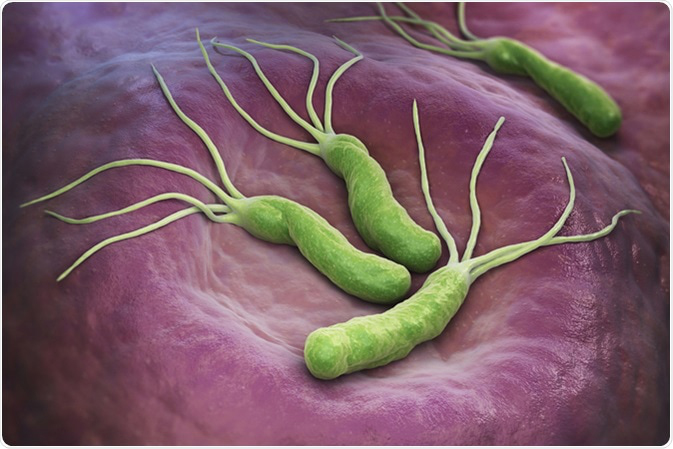What, when and how to test and treat – Helicobacter Pylori ?
February 19, 2019 ,5:27 am

What is H. pylori?
- Bacilli
- Survives in the acidic milieu of stomach
- Affects 30%-40% population (US data)
- GCC data….limited
- UAE......Expected 30-60% (Limited data)
- Oro-oral or feco-oral transmission
Implications…..
Definite associations
- Peptic ulcer disease (PUD)
- 90% with PUD……HP positive
- But only 15% on HP infected have PUD
- Stronger association for duodenal than gastric ulcer
- Gastric MALT lymphoma
- Gastric cancer (HP is a class 1 carcinogen)
Possible associations
- Functional dyspepsia
- Iron deficiency anemia
- Idiopathic thrombocytopenic purpura (ASH recommends testing for HP in ITP and treatment if positive)
Doubtful associations (Poor data)
- Lymphocytic gastritis, Gastric hyperplastic polyps
- Hyperammonemia and hepatic encephalopathy
- Hyperemesis gravidarum
- Myocardial infarction and Stroke
- Parkinsonism
- Urticaria
- High HbA1c
- Allergic or atopic disease
Un-indicated testing for H. pylori results in:
- Un-necessary treatment
- Higher antibiotic exposure
- Higher antibiotic resistance
Who should be tested?
- Active peptic ulcer disease
- Past history of PUD (If not treated for HP therapy in past)
- Low-grade gastric MALT lymphoma
- History of endoscopic resection of early gastric cancer
(ACG 2017 guidelines; Strong recommendation; quality of evidence: high for active or history of PUD, low for MALT lymphoma, low for history of endoscopic resection of EGC)
In uninvestigated dyspepsia, < 60 years and without alarm features, non-endoscopic testing for H.pylori infection is a consideration (Test and treat strategy).
(ACG 2017 guidelines; Conditional recommendation; quality of evidence: high for efficacy, low for the age threshold)
When upper endoscopy is undertaken in patients with dyspepsia, gastric biopsies should be taken to evaluate for H. pylori infection.
(ACG 2017 guidelines; Strong recommendation; high quality of evidence)
In patients taking long-term, low-dose aspirin, testing for H. pylori infection could be considered to reduce the risk of ulcer bleeding.
(ACG 2017 guidelines; Conditional recommendation; moderate quality of evidence)
Patients initiating chronic treatment with NSAID should be tested for H. pylori infection.
(ACG 2017 guidelines; Conditional recommendation; low quality of evidence)
Patients with unexplained iron deficiency anemia despite an appropriate evaluation should be tested for H. pylori infection.
(ACG 2017 guidelines; Conditional recommendation; low quality of evidence)
Adults with idiopathic thrombocytopenic purpura (ITP) should be tested for H. pylori infection
(ACG 2017 guidelines; Conditional recommendation; very low quality of evidence)
Gastroesophageal Reflux Disease (GERD)
The dilemma…..to test or not??
Patients with typical symptoms of GERD who do not have a history of PUD need not be tested for H. pylori infection. However, for those who are tested and found to be infected, treatment should be offered, acknowledging that effects on GERD symptoms are unpredictable.
(ACG 2017 guidelines: Strong recommendation; high quality of evidence)
Pros for not testing
- H. pylori infection is known to have protective impact on GERD/GERD symptoms (negative) association
- HP eradication has been shown to be associated with worsening GERD symptoms
- Inadequate data regarding GERD improvement with HP eradication
- No proven causal association between HP and GERD
Cons for testing
- H. pylori is a Class I carcinogen……..Missing a window for testing and eradicating
- Limited beneficial data (Though inadequate)
Whom NOT to test routinely??
- Asymptomatic individuals with a family history of gastric cancer/HP infection
- Patients with lymphocytic gastritis
- Hyperplastic gastric polyps
- Hyperemesis gravidarum
How to test?
|
Non invasive |
Invasive (Requires OGD) |
| Urea breath test (UBT) | Rapid Urease test (RUT) |
| Stool HP antigen test (SAT) | Histology & Special staining |
| Blood anti-HP antibodies (HP serology) | Biopsy with bacterial culture or PCR |
- PPI, Antibiotics and bismuth preps reduce the test sensitivity
- Serology not preferable for documentation of eradication; use UBT > SAT
- Serology might not differentiate between active and past infections effectively
- Best noninvasive test: UBT
- PPI should be stopped for 2 weeks & antibiotics for 4 weeks before testing
- H2RB minimal effects on test sensitivity
- Antacids have no effect on test sensitivity
- 2 from antrum (2-3 cm proximal to pylorus; one each from lesser and greater curvature aspects)
- 2 from corpus (8 cm from cardia; one each from lesser and greater curvature aspects)
- 1 from incisura angularis
Treatment
- Triple or Quadruple therapy for a duration of 14 days
- Minimum 2 antibiotics + 1 PPI combinations preferable
- Inadequate drugs, dosing and duration impairs treatment efficacy
- Basic regimen: (Amoxicillin 1 g + Clarithromycin 500 mg + PPI) BD x14 days
- Due to higher degrees of drug resistance there are many advanced regimens
- Levflox/Rifabutin based triple therapy
- Bismuth containing quadruple therapy
- Concomitant therapy
- Sequential therapy
- Hybrid therapy
Choice of PPI in triple therapy
- Any PPI may be used
- High dose (40mg ) twice daily PPI is recommended
- Duration recommended is 14 days



